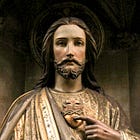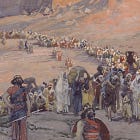'Wolves in sheep's clothing' – perfect description of heretical teachers
The foulest heretics always present themselves as angels of light, citing Scripture and mimicking the Church – but beneath the externals lies a hatred for truth and souls.

The foulest heretics always present themselves as angels of light, citing Scripture and mimicking the Church – but beneath the externals lies a hatred for truth and souls.
Editor’s Notes
Did you miss our 1,000 subscriber milestone post? Check it out here:
In this section, Fr. Coleridge tells us…
How heretical teachers reveal their true nature through restless zeal and hidden self-interest.
That they never act alone, but seek to destroy others’ faith to ease their own torment.
Why even their most poisonous errors must be dressed in the garb of truth to deceive the flock.
Coleridge explains how those who set themselves up as alternative authorities invariably end up with a form of tyranny which would never be possible in the Church.
Parts of this passage may appear to be problematic for Catholics who have refused to go along with the religious revolution that has taken place since Vatican II. However, these difficulties are only apparent:
Coleridge’s treatment of those who usurp authority may well apply to the “traditional clergy” who go beyond the merely sacramental ministry for which they were ordained – but it does not apply to those who maintain an awareness of their role.
His treatment of those who refer to the fathers or the historical Church against the living authority may also seem to apply; however, there are crucial differences – detailed by The WM Review here:
To compare the actions of “traditionalists” with what Coleridge rightly condemns is simply to misunderstand the situation, and to fail to draw crucial distinctions.
For more on the context of this episode, see Part I.
See also the below on this topic:
Christ warned us about those who hide their errors under the guise of orthodoxy:
Beware of false prophets, who come to you in the clothing of sheep, but inwardly they are ravening wolves.
By their fruits you shall know them. Do men gather grapes of thorns, or figs of thistles? Even so every good tree bringeth forth good fruit, and the evil tree bringeth forth evil fruit. (Mt. 7.15-17)
He does not say “believe that they are sheep, because otherwise you are being uncharitable.”
He does not say “it is a spiritual discipline to read their works and try to find some good in them.”
He says: “Beware.”
The False Prophets
The Sermon on the Mount (To the End of the Lord’s Prayer)
Chapter XV
The False Prophets. St. Matt. vii. 15—20;
Story of the Gospels, § 34
Burns and Oates, London, 1878
Why did Christ warn of false teachers so early in His ministry?
What is the ‘appetite for destruction’ that drives false prophets?
Why the Apostles and New Testament so fiercely condemned heresy
What the founders of heresies and false religions have in common
'Wolves in sheep's clothing' – perfect description of heretical teachers
Image of the wolf
The image of the wolf, which is the first which our Lord here uses, is kindred to that of the dog, of which we had lately to speak when commenting on a former verse of this same Sermon. But it conveys the idea of aggression and hungry rapacity, as well as of destructiveness, more than that former image.
This is one of the chief characteristics of the heretical spirit.
Father Coleridge Reader is a labour of love. But curating, cleaning up and publishing these texts takes real work.
To keep this project going, and to make more of this treasury available, we rely on reader support. Some posts are reserved for members to sustain this mission.
We’re trying to keep something precious alive.
If you’ve benefited, consider joining us as a subscriber. It makes a real difference.




